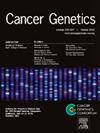慢性髓性白血病患者的不利疾病进展和并发t(6;9)易位(DEK::NUP214融合)或倒位16 (CBFB::MYH11融合)
IF 2.1
4区 医学
Q4 GENETICS & HEREDITY
引用次数: 0
摘要
费城染色体阳性(pH+)细胞中额外特异性染色体异常的发生与慢性髓性白血病(CML)的疾病进展相关,并且被认为是定义CML加速/母细胞期的标志物。DEK::NUP214融合和CBFB重排在CML中极为罕见,其预后意义尚不清楚。在这里,我们提出两个CML病例,其中一个病例有并发易位6;9 [t(6;9)]导致DEK::NUP214融合,另一个同时呈现倒置16 -inv(16)-导致CBFB::MYH11融合。在急性髓性白血病(AML)患者中,t(6;9)常与预后不良相关。在这种情况下,患者未能达到缓解并死亡。这表明t(6;9)也与CML预后不良有关。然而,需要更多的数据来验证这种关联。通过核型检测inv(16)在技术上具有挑战性。此外,CBFB的FISH通常不会在CML的背景下进行,从而增加了类似病例可能被误诊的可能性。随着新一代测序(NGS)技术在基因融合检测中的常规应用,更多像这样的患者应该得到相应的诊断和治疗。这些病例说明了全面的分子/细胞遗传学诊断检查的重要性。本文章由计算机程序翻译,如有差异,请以英文原文为准。
Unfavorable disease progression in patients with chronic myeloid leukemia and concurrent t(6;9) translocation (DEK::NUP214 fusion) or inversion 16 (CBFB::MYH11 fusion)
The occurrence of additional specific chromosomal abnormalities in Philadelphia chromosome-positive (pH+) cells is associated with disease progression in chronic myeloid leukemia (CML), and is considered a marker that defines the accelerated/blast phase of CML. Both DEK::NUP214 fusion and CBFB rearrangement are extremely rare in CML, and their prognostic significance is unknown. Here we present two CML cases, with one case having concurrent translocation 6;9 [t(6;9)] leading to DEK::NUP214 fusion, and the other one presenting with concurrent inversion 16 -inv(16)- leading to CBFB::MYH11 fusion. The t(6;9) is usually associated with poor prognosis in acute myeloid leukemia (AML) patients. In this case, the patient failed to achieve remission and expired. This suggests that the t(6;9) is also associated with poor prognosis in CML. However, more data is needed to verify this association. Detection of inv(16) by karyotyping is technically challenging. In addition, FISH for CBFB is not usually run in the context of CML, thus raising the possibility that similar cases may have been underdiagnosed. With the routine use of next-generation sequencing (NGS) for gene fusion detection, more patients like this one should be diagnosed and treated accordingly. These cases illustrate the importance of a comprehensive molecular/cytogenetic diagnostic work-up.
求助全文
通过发布文献求助,成功后即可免费获取论文全文。
去求助
来源期刊

Cancer Genetics
ONCOLOGY-GENETICS & HEREDITY
CiteScore
3.20
自引率
5.30%
发文量
167
审稿时长
27 days
期刊介绍:
The aim of Cancer Genetics is to publish high quality scientific papers on the cellular, genetic and molecular aspects of cancer, including cancer predisposition and clinical diagnostic applications. Specific areas of interest include descriptions of new chromosomal, molecular or epigenetic alterations in benign and malignant diseases; novel laboratory approaches for identification and characterization of chromosomal rearrangements or genomic alterations in cancer cells; correlation of genetic changes with pathology and clinical presentation; and the molecular genetics of cancer predisposition. To reach a basic science and clinical multidisciplinary audience, we welcome original full-length articles, reviews, meeting summaries, brief reports, and letters to the editor.
 求助内容:
求助内容: 应助结果提醒方式:
应助结果提醒方式:


